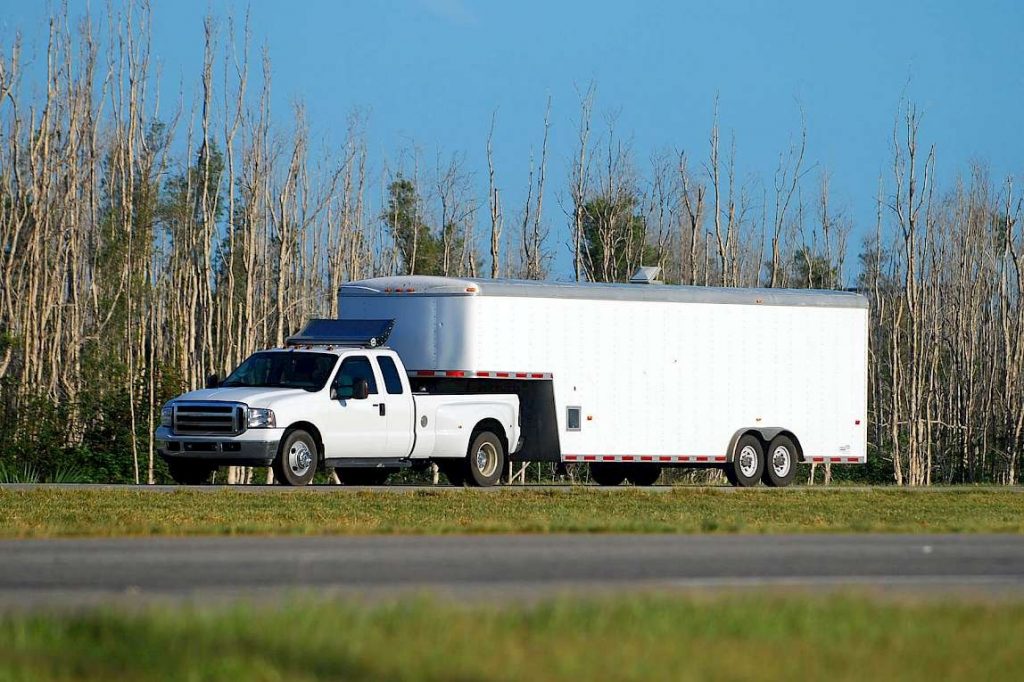Hot shot trucking has become an increasingly popular transport business in recent years, as it allows companies to quickly move LTL (Less than truckload) freight across states in a record time. This makes it cheaper for companies to provide a time-sensitive effective shipping option.
Read about What is Hotshot Trucking.
What Kind of Trailers Are Used for Hotshot Driving?
Most hotshot trailers are class 3, 4, or 5 trucks or medium vehicles with a flatbed to allow for more shipping room; this is something most people already know. However, when it comes to trailers, things get a bit confusing. So, here are the most popular kinds of trailers used as hot shots:
1. Bumper pull trailer
Bumper pull trailers have one special feature, which serves both as their greatest profit and drawback, their weight. These kinds of trailers are designed for small and light loads, making them a speedy, light option for transport. They’re also convenient and easy to use.
Another major benefit of bumper pull trailers is that they don’t require the driver to obtain a Commercial Driver’s License, as the license is necessary if the combined weight of cargo and trailer exceeds 10001 pounds. And here is where a great drawback kicks in, the weight limit. Bumper pull trailers are likely to sway or lose stability under heavy weights.
To make the most out of these trailers, drivers should use them for short-haul transportation, commercial delivery, and small-scale freight. These trailers work best for new startups and people who want to ease into the business.
2. Gooseneck trailers
Gooseneck carriers are suitable for hauling heavier loads instead of bumper pull trailers. Because of that, some states require a special certificate to operate them. These trailers are great for owner-operators who want to commit themselves to hotshot trucking as a continuous business.
The best thing about Gooseneck trailers’ is their dependable performance over long stretches and their stable turning radius. However, they require a specific hitching system to attach to the truck.
With the proper equipment, these trailers can serve as a great investment to expand your business to larger loads.
3. Dovetail trailers
Dovetail trailers allow you to load any freight with wheels on their flatbeds; this feature makes loading cargo almost effortless. They are also affordable and accepted, so they are easy to resell if you quit hotshot driving.
On the other hand, with dovetail trailers, it’s easy to get rear-ended as their low bumpers drag on the ground. In addition to that, they’re known to reduce the flat space by a considerable amount.
4. Tilt deck trailers
The tilt deck combines the best features of both goosenecks and dovetails. The tilting mechanism, operated hydraulically, allows for smooth cargo loading from the ground level, reducing the chances of damages caused by the manual lifting of heavy cargo.
The most outstanding drawback to these trailers is that they require more regular maintenance than other hot shot carriers. For example, the hydraulic system in tilt deck trailers needs regular oil changes, lubrication, and occasionally replacement of many moving parts.
What are the Requirements for Shot Trailers?
There are precise requirements for hot shot drivers and regulations imposed by the Department of Transportation that every driver must meet:
- If a driver’s combined weight exceeds 10000 pounds, they must have a Commercial Driving License (CDL) to operate the vehicle on public roads; they must have their logbook on the person and follow the Department of Transportation’s rules for driving and resting.
- The vehicle must have a department of transportation–issued license plate and load sticker.
- The driver must also have a valid Motor Carrier Authority (MCA) number and approval from the Federal Motor Carrier Safety Administration (FMCSA).
- To make hot shot driving a real, long-term business, drivers must pass a physical exam required by the Federal Motor Carrier Safety Administration (FMCSA).
Why You Should Get into Hot Shot Trucking
- Adding hot shot delivery to your freight service will vary your options for serving clients. And it will not cost you more than two trailers, a gooseneck trailer for transporting large loads, and a bumper tail for smaller ones. Those two trailers alone can provide services to a large scale of customers, help retain customers, and broadens the scope of deliveries available through your company.
- In addition to being versatile, Hot shot deliveries are popular and widely accepted. Many customers prefer hotshot trucking over other transportation methods because it’s economical, convenient, fast, and efficient.
- Hot shot delivery is faster and requires few resources. The trucker does not have to wait in line at a depot or return the hot shot delivery truck to a designated area.
- Hot shot deliveries can provide an extra source of income for small truck owners, as well as a means to make money by using the equipment they already own. They are also a way for hotshot delivery drivers with more volume to get on with larger companies.
Conclusion
While there are many methods to transport goods and freight, hot shots remain the best option for people who want to ship light loads quickly. They’re a great investment for both startups and prestigious companies.
